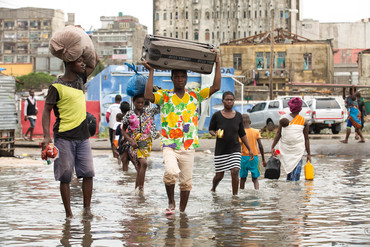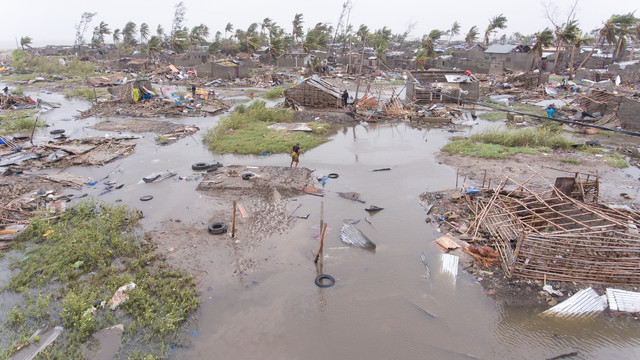How can loss and damage finance reach those enduring climate catastrophe?
As global heating causes loss and damage to escalate rapidly, new and additional large-scale financing is needed to protect lives, livelihoods and ecosystems, especially in the poorest countries and communities. Clara Gallagher and Simon Addison explore some of the ways that different financial instruments might be layered to get the right kinds of finance to the right place at the right time to implement a variety of loss and damage measures.


Loss and damage refers to the adverse impacts of climate change that have not, cannot, or will not be avoided by mitigation or adaptation. As global heating escalates, so too do the losses and damages being incurred around the world – from loss of life and livelihoods to health and wellbeing, culture and social identity, land and shelter and infrastructure and GDP.
Why is loss and damage finance critical?
Loss and damage can only be addressed through concerted action to respond to the wide range of climate impacts that will affect a country or community over different timeframes, using comprehensive approaches that layer different solutions in coordinated and complementary ways.
Loss and damage financing, therefore, needs not only to deliver disaster response and reconstruction but also to anticipate and prevent communities from losing their development gains. It must enable countries and households to endure and bounce back from the impacts of loss and damage when they have already done all they can to adapt.
The costs of addressing loss and damage in developing countries will be immense. Estimates of the damage in developing countries range from US$290 billion to $580 billion by 2030. The ongoing calamitous floods in Pakistan are a case in point: early estimates suggest that the economic costs will reach a minimum of $10 billion.
But these costs will be dwarfed by those caused by non-economic forms of loss and damage – loss of life, health, wellbeing, territory, cultural identity, Indigenous knowledge, biodiversity and more – which are rarely captured by formal estimates.
Existing forms of finance are not sufficient to deliver the type and scale of action required to address loss and damage effectively. Not only are they inappropriate to tackle the complexity of loss and damage on their own, but they are also woefully inadequate to meet the rising needs of affected countries and communities. New and additional finance is therefore crucial.
What is a loss and damage response?
Climate hazards affect people in different ways depending on the severity of the hazard and people’s levels of exposure, vulnerability and adaptive capacity. Losses and damages will also vary over time as climate hazards intensify and compound one another.
Efforts to address loss and damage must therefore be grounded in the everyday realities of loss and damage risk and tailored to the vulnerabilities of different people and places to different hazards over time.
The question of how to finance action to address loss and damage is therefore not only about how to mobilise the trillions of dollars required to finance responses after a disaster but also about how to ensure the right kinds of finance reach those who are about to experience loss and damage, or who will be unable to avoid it in the future.
Different forms of finance are therefore required to fund different types of responses to tackle different types of loss and damage over different time frames.
How can money reach those who need it the most?
There are many examples of existing financial delivery mechanisms that could be adapted to channel funds into the hands of those about to or already experiencing loss and damage.
Delivery mechanisms refer to the assortment of arrangements that could channel flexible, transparent, accountable finance to local actors to enable them to address loss and damage on their own terms. Such mechanisms include social protection, devolved climate finance mechanisms for investing in public goods at the local level and urban poor funds used to build community resilience.
Such delivery mechanisms might be adapted to carry different layers of response to address loss and damage. Take social protection: Ethiopia’s Productive Safety Net Programme (PSNP) uses layers of intervention to tackle a variety of risks. Cash and food transfers are used to increase the households’ long-term coping capacity by addressing underlying drivers of vulnerability, while contingency finance is used to support recipients in an emergency, such as a drought or flood.
An additional line of pre-arranged contingency finance provides an additional layer of protection if shocks threaten to push better-off households into poverty.
While the PSNP isn’t designed to facilitate action on loss and damage, it could be adapted to do so. For instance, a safety net could be provided to people forced to migrate from their homes due to climate shocks – making the social protection 'portable'.
This extra layer could support safe temporary migration and protect marginalised groups, such as women and children, from exposure to post-disaster forms of exploitation, slavery and trafficking.
Using an existing channel that enables the recipient of the finance to choose how they want to spend cash or how they want to prioritise community projects devolves the decision making and agency to those that are experiencing loss and damage and so have the best knowledge of their needs.
The need for progress is urgent
The urgency of addressing loss and damage is clear. The agenda for loss and damage finance has moved considerably in recent years but so too has the intensity of climate impacts.
As COP27 approaches, commitments to new and additional dedicated loss and damage financing must be secured. Finance mobilisation is a key first step – however we must also consider how the money will flow to those that need it most. Could existing delivery mechanisms be adapted to suit this purpose?
- Read more on how layering interventions is necessary to address loss and damage effectively
- Read how it's important to understand the history, politics and power dynamics that create vulnerability to loss and damage





